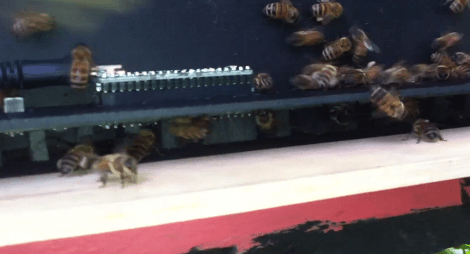This is the bee counter which [Hydronics] designed. It’s made to attach to the opening for a hive, and will count the number of bees entering and exiting. We’re not experienced bee keepers ourselves (in fact we’re more of the mind of getting rid of stinging beasties) but we understand their important role in agriculture and ecosystem so we’re glad someone’s making a nice home for them.
Most of the apparatus is a circuit board lined with reflective sensors. There is a double-row of pin sockets on the top of the board which accepts the Teensy+ which monitors those sensors. The bees must pass below this PCB every time they enter or leave the hive, thereby tripping a sensor. In the video after the break [Hydronics] shows off the system with a netbook used to monitor the output. But it sounds like he has plans for an integrated display system in future versions of the bee counter.

















…wont one bee be counted multiple times?
it counts number of bees in the hive – assuming all entrances covered it won’t
No, it only tells you how many bees aren’t in the hive at the moment, assuming that there is at least one point in the day where all of the bees are inside the hive.
If a bee flies in – it will be counted.
If it flies out – it will be counted again.
And so on – afaik.
It uses 2 sensors at each opening, to detect the direction the bee is traveling.
Does it handle traffic jams? Eg how would it handle a bunch of bees in a string? How about if a bee just decides to chill out between (or directly under) one of the sensors?
We just generally count their legs & divide by six.
If he used sensors from quadrature encoders,they have 2 ir beams to break….he could tell direction. most inkjet printers have 2 encoders in them….cheap+avalable..
If you go to the instructible page and click on step #3 (the picture of the long purple circuit board)…
http://www.instructables.com/id/Honey-Bee-Counter/
… you can see there’s 2 sensors at each opening. If you mouse-over the image, the tooltip he provided for the image says “…. two gates per inch, two sensors per gate, 22 gates, 44 sensors, ~12 inches long”.
There’s also an Arduino sketch on that page which seems to read 4 of the sensors and increment separate “ins” or “outs” counters based detecting changes and looking at the 2 readings to infer direction of movement. There are some comments in the code which explain how it works, such as:
if (lai != ai){ // has the status if the 1st pin changed?
if (ai > ao) { // if yes, is the bee going in or out?
ins++; // if its going in add one bee to ins
There’s just the slight problem that bees really hate electricity, because they sense the weak electrical fields coming off of the device.
Similiar to how red ants will climb into junction boxes and traffic lights and short them out. Something in the potential field makes them flip out.
http://www.hese-project.org/hese-uk/en/papers/warnke_bee_world_76.pdf
Interestingly enough, it’s theoretically possible to count the number of bees coming and going from the hive by measuring the change in the static charge they carry.
However: “Colonies subjected to electromagnetic oscillations (10-38 kHz 800 V/m) produce a changed pattern of sound and their temperature increases. Given a choice, bees will evade such oscillations.”
That PDF was fascinating! *starry eyed*
Yes, but since when are you going to have an electromagnetic field of 800 volts per meter next to your beehive? It’s rather unlikely.
Now they just need to add a pair of xbees to transmit the data wirelessly.
Interesting solution in gathering data. Since honeybees are suffering from massive colony loss in some areas, this is yet another method to eliminate anecdotal data and log the actual downsizing of the colony in real time. Fun stuff.
I thought most insects hate UV light and infrared. I may be totally wrong on this one but wouldn’t it cause a disruption? maybe you can paint numbers on all of them instead
Aw, I was hoping for a little tiny time clock with little tiny punch cards and trained bees that use them.
Currenly in the netherlands another bee project project is going on: Bee Tracking System – Live data from Floriade Bee hive. Tracking system with rfid chipped bees to investigate causes of massive bee collapse disorder.
http://www.nspyre.nl/rfibee/
Great jokes! But seriously could a bee turnstile function in a gate-channel. The offending Ir would be inside the housing. It would eliminate stinger-gating bees from not tallying. They are busy and in a hurry just like subway riders.
I love bees, they are fascinating and they make 1/3 of the food chain possible.
Q1: How do you know the total count of bees that live in the hive? Please don’t say you just add/subtract the numbers.
Q2: Assuming that’s remotely possible to determine with this method, how long do you have to wait until you determine it?
Q3: Do you know how real bee keepers count bees? How is this project improving that method?
PS. Nice eye candy iPhone photos, it will sell your project regardless of anything else (-: